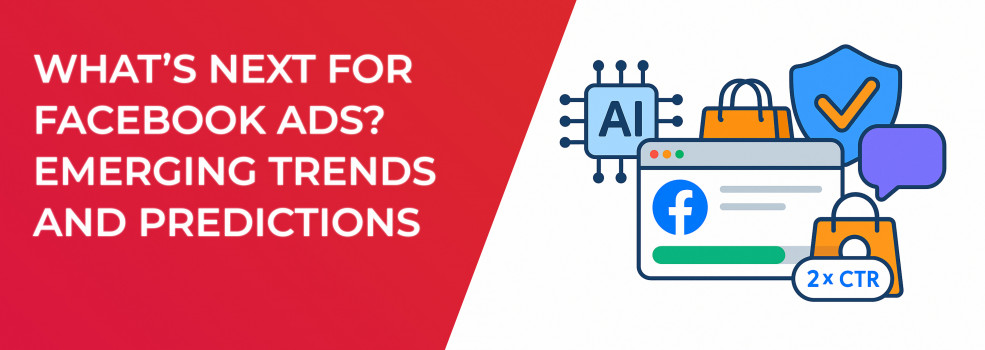Facebook Ads never sit still. Since early 2024 the channel has raced through tighter privacy rules, AI-first automation and richer creative formats. Marketers who track Facebook ad performance, keep refining Facebook ad optimization and stay connected to new ways to find customers on Facebook will profit most in 2025 and beyond.
A Quick Pulse Check on 2025
Facebook’s audience growth has plateaued, yet engagement is deepening in vivid new surfaces such as Reels and in-app Shops. That shift matters because impressions keep climbing while CPMs remain relatively steady, opening room for efficiency gains if you optimise toward the right objectives.
Before we dive into specific trends, let’s align on the current numbers that matter most.
-
Reels now command more than 50% of total time spent in the Meta family of apps, which in turn drives a higher click-through rate on Facebook ads for vertical-video placements.
-
The feed’s new AI recommendations have increased ad impressions on Facebook, letting advertisers reach more qualified eyeballs with similar budgets.
-
Brands benchmarking against the average conversion rate on Facebook ads and regularly comparing to industry-specific Facebook advertising benchmarks are still enjoying ROAS lifts of roughly 20%.
Taken together, these datapoints tell us that the next wave of growth will come from squeezing additional value out of each impression rather than simply chasing more reach.
Five Trends Poised to Reshape Your Strategy
The following sections outline the most important shifts already under way. Each trend is paired with an action step so you can translate insight into performance — and so your campaigns don’t lag behind the competition.
1. AI-Driven Automation Goes Mainstream
Meta’s Advantage+ suite now reallocates budget in real-time toward the highest-value conversions, smoothing out the volatility that once plagued the learning phase Facebook ads must pass through.
Automation in action: Advantage+ turns dozens of toggles into a single progress bar.
Action step: Maintain at least fifty conversions per ad set per week and refresh audiences regularly to feed the algorithm enough data for precise delivery.
2. Privacy-Safe, First-Party Data Takes Centre Stage
As third-party cookies exit the stage, robust custom audiences, lookalike audiences and server-side Conversion API (CAPI) integrations have become table stakes rather than “nice-to-have” extras.
Action step: Map every consent touch-point in your funnel, then sync hashed emails to Meta weekly so you retain targeting accuracy without infringing on privacy legislation.
3. Conversational Commerce Explodes
Click-to-Message ads across Messenger, Instagram DMs and WhatsApp now achieve double the Facebook ad engagement rate of standard traffic campaigns, largely because they blend reach with one-to-one interactivity.
Messenger tap-to-buy journeys boost click-through while slashing acquisition cost.
Action step: Pair your top-performing creative with a Messenger welcome flow, answering FAQs and collecting purchase signals inside the chat window.
4. Social Commerce Becomes Seamless
The expansion of Facebook Shops to twenty-five markets, including frictionless checkout and Live Shopping tools, produces an in-app journey that keeps users from dropping out.
Action step: Redirect cart-abandoners to product-highlight Reels followed by retargeting on Facebook ads that offer limited-time incentives.
5. Augmented Reality and Interactive Formats Mature
Virtual try-on experiences for beauty and apparel brands are registering thirty-percent lower CPAs compared with static image ads, while playable and quiz formats that began in mobile gaming are now powering B2B lead generation.
Action step: Rotate at least two AR-enabled creatives every quarter to stay ahead of audience fatigue and to signal to Meta’s delivery system that you can handle immersive experiences.
Speed up AR creative production by tapping one of the best AI text and image generators reviewed by our team.
Putting it all together, the unifying theme is experience enrichment: audiences respond best when ads blend utility, conversation and relevance.
A Glimpse into 2026 and Beyond
To translate the foregoing trends into a roadmap, consider the table below as a living forecast. It summarises four macro-shifts and the concrete actions needed to stay competitive:
The real-world implication is simple: brands that plan campaigns around “zero-friction” in-app behaviours and automated measurement will leapfrog those still chasing last-click website visits.
Your 2025 Optimization Playbook
Optimisation remains an ongoing discipline rather than a one-time task. The following five-step playbook provides a practical starting point that you can revisit every sixty days:
-
Audit Your Funnel Thoroughly
Begin by mapping every step from the initial impression to final sale. Identify where prospects leak out, then plug holes with Messenger follow-ups or warm-audience retargeting. -
Lean Into Broad Targeting First
Broad, signal-rich ad sets let the algorithm hunt for incremental pockets of demand. Layer in lookalike audiences only after performance plateaus. -
Refresh Creative on a Cadence
Rotate at least four distinct concepts per ad set. Evaluate success on ad engagement rate and average watch time, not just clicks. Spot trouble early by tracking repeat-view thresholds outlined in our Ad Fatigue on Facebook checklist. -
Pair Automation With Guardrails
Use Advantage Campaign Budget for scale, but set bid caps on your highest-margin SKUs to maintain cost predictability. -
Measure What Actually Matters
Track the full-funnel mix of ROAS, CPM, CTR and conversion rate on Facebook ads. Compare each metric to quarterly Facebook advertising benchmarks so you know when fluctuations are industry-wide and when they are unique to your account.
By integrating these steps into your workflow you’ll stay nimble, ensuring that fresh creative, audience signals and budget strategies keep pace with Meta’s rapid-fire updates.
Wrapping Up
The next era of Facebook advertising rewards marketers who balance data discipline with fearless creative experimentation. By honing in on real-time Facebook ad performance signals, nurturing privacy-compliant first-party audiences and embracing AI-driven optimisation, you will find, engage and convert more customers on Facebook than your competitors.

